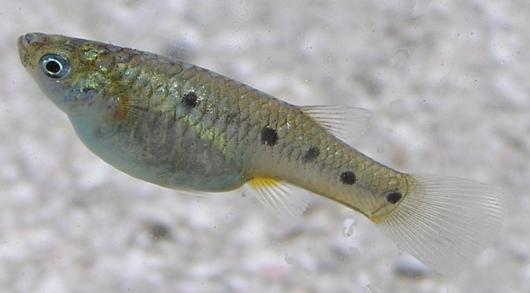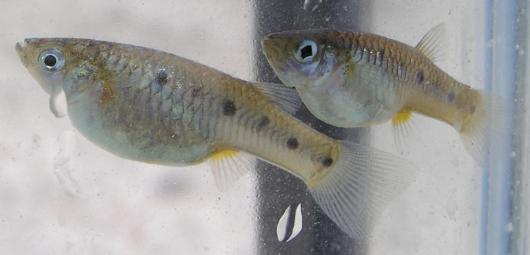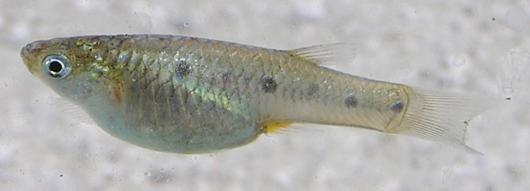Porthole Livebearer
-
Scientific NamePoeciliopsis gracilis
-
NativeNon-Native
-
Identification
 Porthole livebearer, female. Location: Irrigation drain (Oasis-Grant) at the north end of the Salton Sea. Length: approximately 40 mm TL. Date: 5/20/2010. Photo by Sharon Keeney, California Department of Fish and Game.
Porthole livebearer, female. Location: Irrigation drain (Oasis-Grant) at the north end of the Salton Sea. Length: approximately 40 mm TL. Date: 5/20/2010. Photo by Sharon Keeney, California Department of Fish and Game. Porthole livebearer, two females. Location: Irrigation drain (Oasis-Grant) at the north end of the Salton Sea. Length: approximately 40 mm TL. Date: 5/20/2010. Photo by Sharon Keeney, California Department of Fish and Game.
Porthole livebearer, two females. Location: Irrigation drain (Oasis-Grant) at the north end of the Salton Sea. Length: approximately 40 mm TL. Date: 5/20/2010. Photo by Sharon Keeney, California Department of Fish and Game. Porthole livebearer, female, left side. Location: Irrigation drain (Oasis-Grant) at the north end of the Salton Sea. Length: approximately 40 mm TL. Date: 5/20/2010. Photo by Sharon Keeney, California Department of Fish and Game.
Porthole livebearer, female, left side. Location: Irrigation drain (Oasis-Grant) at the north end of the Salton Sea. Length: approximately 40 mm TL. Date: 5/20/2010. Photo by Sharon Keeney, California Department of Fish and Game.- Chunky body with large eyes and a small head
- Long gonopodium from rays of the anal fin extends nearly to the caudal fin
- Rounded tail
- Short dorsal fin entirely behind the base of the anal fin
- 29 large scales on the lateral line
- Pale brown and translucent with 3-8 large black spots running down each midline usually on the rear of the body
-
Life History
Most information about the porthole livebearer is gathered from aquarium fish but wild populations are known to exist near the Salton Sea. They have been found in drains with salinities up to 18 ppt and temperatures as high as 26-28°C and seem to prefer shallow, flowing waters. They are an omnivorous species and will eat from both the bottom and water column of their chosen area. Most only live to be a year old, growing to approximately 75 mm. Males are mature by the time they are 22-25 mm and will defend small territories to attract females. Females do not mature until they reach 36 mm in length. Females can hold between 1 and 140 embryos at a time and can reproduce all year long in the right conditions. In the Salton Sea these conditions are only found during the summer and therefore reproduction does not occur during the winter in California.
-
Links to Other ResearchN / A
-
WatershedN / A
Please note, watersheds are at the USGS 8-digit Hydrologic Unit Code (HUC) scale, so they often include a lot of sub-watersheds. If a species occurs in any sub-watershed within the HUC, the species appears within the HUC. Link to an EPA page that shows HUCs.


